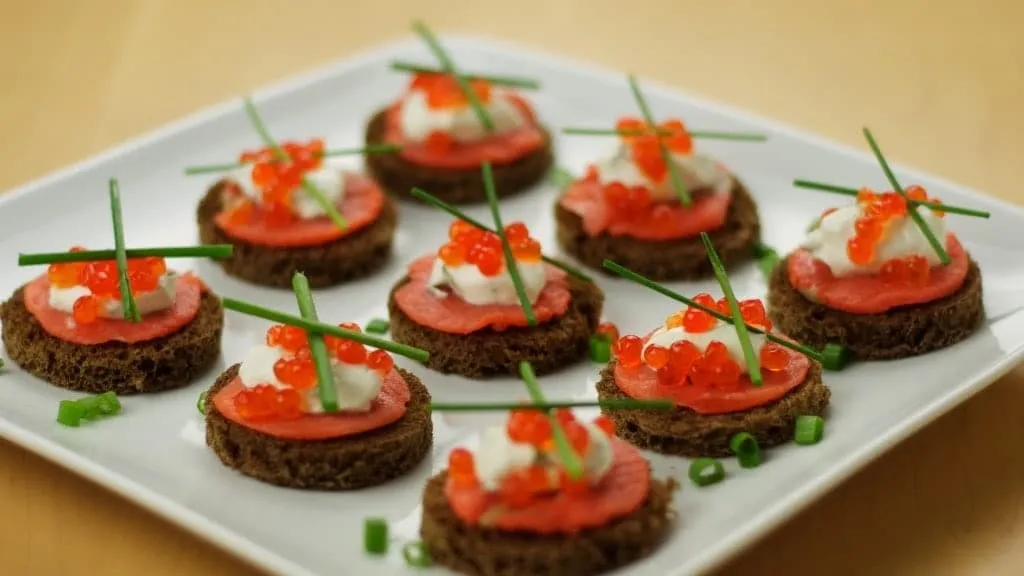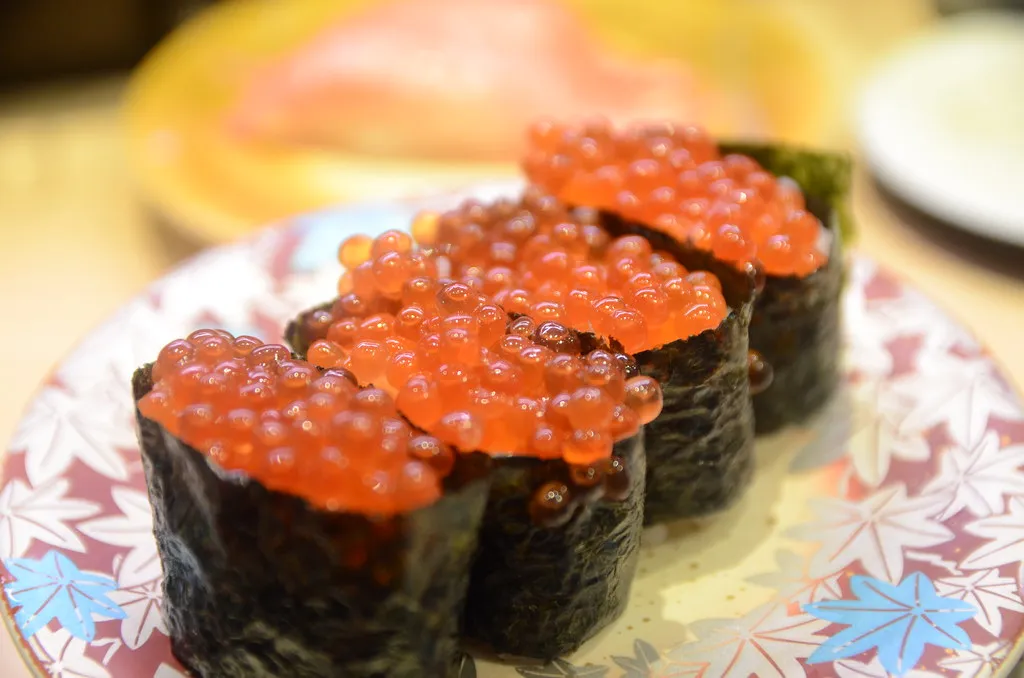The Best Fluffy Pancakes recipe you will fall in love with. Full of tips and tricks to help you make the best pancakes.
Salmon caviar, also known as salmon roe, is a luxurious yet accessible delicacy enjoyed in cuisines around the world. With its rich, briny flavor and vibrant orange pearls, this gourmet ingredient is often found in sushi, seafood dishes, and elegant appetizers. But did you know you can easily prepare and serve salmon caviar at home?
Not only is salmon roe packed with Omega-3 fatty acids, protein, and essential vitamins, but it also adds a burst of flavor and texture to various dishes. Whether you’re looking to cure fresh salmon eggs yourself or simply find creative ways to enjoy them, this guide will walk you through everything you need to know. From sourcing and preparing to storing and serving, you’ll learn how to make the most of this exquisite seafood treat.
What Is Salmon Caviar?
Salmon caviar, commonly known as salmon roe, is the unfertilized eggs of salmon, prized for their delicate texture, rich umami flavor, and vibrant orange or red hue. It is widely used in sushi, seafood dishes, and gourmet appetizers, offering a briny yet slightly sweet taste that enhances various culinary creations. While traditional caviar is associated with sturgeon roe, salmon caviar is a more accessible and equally delicious alternative.

What Makes Salmon Roe Different from Traditional Caviar?
Many people wonder how salmon roe compares to traditional caviar, which is typically made from sturgeon eggs. Here are some key differences:
- Size and Appearance: Salmon roe is significantly larger than sturgeon caviar, with eggs ranging from 4 to 7mm in diameter. Their bright orange-red color makes them visually striking.
- Flavor Profile: While sturgeon caviar has a mild, buttery taste, salmon caviar has a brinier, more intense seafood flavor, making it a bolder choice.
- Price and Availability: Traditional caviar, especially from beluga or osetra sturgeon, is extremely expensive due to its rarity. Salmon caviar is more affordable and widely available, making it a great entry point into the world of caviar.
Health Benefits of Salmon Caviar
Beyond its gourmet appeal, salmon roe is a nutrient powerhouse, offering numerous health benefits:
- Rich in Omega-3 Fatty Acids: Salmon roe is loaded with DHA and EPA, essential fatty acids that support brain function, heart health, and reduce inflammation.
- High-Quality Protein: With more than 30% protein content, salmon caviar is a great source of amino acids necessary for muscle growth and overall health.
- Packed with Vitamins and Minerals: It contains essential nutrients such as vitamin D, B12, selenium, and iodine, all of which contribute to immune function, energy levels, and thyroid health.
- Low in Carbohydrates: Ideal for low-carb and keto diets, salmon roe is a healthy, high-fat, and protein-rich food choice.
Where to Buy Fresh Salmon Roe
If you’re looking to enjoy salmon caviar at home, sourcing high-quality roe is essential. Here are some of the best places to find fresh salmon eggs:
- Specialty Seafood Markets: Many high-end fish markets and gourmet grocery stores carry fresh or frozen salmon roe.
- Online Retailers: Reputable seafood suppliers offer sustainably sourced, high-quality salmon roe that can be delivered to your doorstep.
- Local Fishmongers and Fish Farms: If you live near coastal areas, check with local fishmongers who sell fresh wild-caught salmon roe.
- Asian and Eastern European Markets: Many Japanese, Russian, and Eastern European markets sell high-quality ikura (Japanese for salmon roe) for sushi or gourmet dishes.
When purchasing salmon caviar, look for firm, glossy eggs with a fresh ocean aroma. Avoid products with an overly strong fishy smell, as this may indicate poor quality or spoilage.
How to Make Salmon Caviar at Home
Making salmon caviar at home is easier than you might think and allows you to enjoy a fresh, high-quality delicacy without the premium price tag. Whether you want to cure fresh salmon roe (ikura) yourself or simply preserve store-bought eggs, this guide will walk you through the essential steps. With a little patience and the right techniques, you can create your own gourmet salmon caviar perfect for sushi, appetizers, or elegant seafood dishes.
Step-by-Step Guide to Curing Salmon Roe
Curing fresh salmon roe is a simple process that enhances its flavor and extends its shelf life. Follow these steps for the best results:
Ingredients:
- 1 lb fresh salmon roe (in skeins or loose eggs)
- 4 cups warm water
- 3 tbsp sea salt (adjust to taste)
- 1 tbsp sugar (optional, for a slightly sweeter flavor)
- Ice water (for rinsing)
Instructions:
1. Remove the Eggs from the Membrane (Skeins)
- If you have whole salmon roe skeins (egg sacs), gently open them using your fingers or a spoon. A sharp knife can also help make precise incisions if needed. Using a high-quality stainless steel knife with a built-in sharpener ensures clean cuts and prevents unnecessary damage to the roe. You can find a great option here on Amazon.
- Submerge the skeins in warm water (about 100°F or 38°C) and carefully separate the eggs. The membrane should loosen, making it easier to remove.
2. Rinse and Clean the Salmon Eggs
- Once separated, strain the eggs and rinse them under cold running water.
- Remove any leftover membrane or impurities to ensure the caviar is clean and smooth.
3. Prepare the Brine for Curing
- In a bowl, mix 3 cups of warm water with 3 tbsp sea salt, stirring until fully dissolved.
- You can add 1 tbsp sugar if you prefer a milder, slightly sweet taste.
4. Cure the Salmon Roe in the Brine
- Place the cleaned salmon eggs into the brine and let them soak for 10 to 30 minutes.
- The longer they sit, the saltier the flavor. Taste-test a small amount after 10 minutes and adjust accordingly.
5. Drain and Store the Caviar
- Once the roe has reached the desired flavor, strain the eggs and rinse them with ice-cold water to stop the curing process.
- Transfer the caviar to an airtight glass jar and store it in the fridge for up to 5 days.
Best Techniques for Preserving Fish Eggs
To keep your homemade salmon caviar fresh and flavorful, follow these preservation techniques:
- Refrigeration: Always store cured salmon roe in an airtight glass container at a temperature between 32-38°F (0-3°C). Avoid plastic containers as they can affect the flavor.
- Vacuum Sealing: If you want to store it for longer, vacuum-seal the roe before refrigerating. This prevents air exposure, preserving the texture and taste.
- Freezing Salmon Caviar: While fresh caviar is best enjoyed immediately, you can freeze it for up to 3 months. Just be sure to thaw it slowly in the fridge before serving to avoid texture loss.
- Avoid Metal Utensils: When handling or serving salmon roe, use wooden, plastic, or ceramic utensils to prevent metallic flavors from affecting the delicate eggs.
Common Mistakes to Avoid When Preparing Salmon Caviar
To ensure the best taste and texture, watch out for these common mistakes:
- Using Excessive Salt: Over-salting the brine can make the roe too salty, overpowering its natural umami flavor. Start with a weaker brine and taste-test before adjusting.
- Not Rinsing Thoroughly: Any leftover membrane or residue from the skein can result in a bitter aftertaste. Always rinse the eggs well after separating them.
- Overcuring the Eggs: Letting the roe sit in brine for too long can make the eggs too firm and overly salty. Stick to the recommended 10-30 minutes soaking time.
- Storing in Plastic or Metal Containers: Plastic containers can absorb flavors, and metal can react with the roe. Always use glass jars to maintain freshness.
The Best Ways to Eat Salmon Caviar
Salmon caviar, also known as ikura, is a luxurious and flavorful ingredient that enhances a variety of dishes. Whether you enjoy it as a simple garnish or the star of a meal, there are countless ways to savor its rich, briny taste and delicate texture. Below are some of the best ways to eat salmon caviar, from traditional pairings to creative culinary ideas.

1. Classic and Traditional Ways to Enjoy Salmon Caviar
Salmon caviar has been enjoyed for centuries, particularly in Japanese, Russian, and Scandinavian cuisines. If you’re looking for an authentic experience, try these classic serving methods:
- On Buttered Toast or Blini
- One of the most traditional ways to enjoy salmon caviar is on buttered toast points or blini (small Russian pancakes).
- The richness of butter and the light texture of blini balance the briny, umami-packed salmon roe.
- Garnish with a touch of sour cream, crème fraîche, or chives for added flavor.
- With Russian-Style Buckwheat Pancakes (Blinis)
- Blinis are a traditional Russian pairing with salmon caviar.
- Serve them warm, with a dollop of sour cream, diced onions, or dill to bring out the natural flavors.
- Simply with a Spoon
- For a pure tasting experience, many caviar lovers enjoy a small spoonful of salmon roe on its own.
- Use mother-of-pearl or wooden spoons instead of metal to avoid altering the delicate taste.
- On Buttered Crackers or Crostini
- A simple way to enjoy salmon caviar is on a buttered cracker or crispy crostini.
- The crisp texture pairs well with the bursting pop of the roe.
2. Salmon Caviar in Sushi and Japanese Cuisine
Salmon roe is an essential ingredient in Japanese cuisine, where it’s known as ikura. It is commonly used in sushi and other seafood dishes, such as:
- Ikura Sushi (Gunkan Maki)
- A gunkan-maki roll consists of rice wrapped in nori (seaweed) and topped with a generous serving of salmon caviar.
- Often garnished with a touch of wasabi for extra heat.
- Ikura Don (Salmon Caviar Rice Bowl)
- A simple yet elegant dish, ikura donburi (ikura don) features salmon roe served over warm sushi rice.
- Often accompanied by thinly sliced shiso leaves, nori strips, or wasabi for a fresh contrast.
- Chirashi (Scattered Sushi Bowl)
- Chirashi sushi is a colorful rice bowl topped with an assortment of raw fish and seafood, including ikura.
- The briny salmon roe pairs well with other sushi ingredients like tuna, salmon, and avocado.
- Topped on Cold Soba or Udon Noodles
- For a light and refreshing dish, salmon roe can be added to cold soba or udon noodles.
- Drizzle with a soy-based sauce and garnish with green onions and sesame seeds.
3. Salmon Caviar as a Gourmet Garnish
Salmon caviar adds a luxurious touch to many high-end dishes. Some creative and gourmet ways to incorporate it include:
- With Scrambled or Poached Eggs
- A simple yet indulgent breakfast idea is creamy scrambled eggs topped with salmon roe.
- The salty, umami-packed caviar enhances the richness of the eggs.
- On Deviled Eggs
- Upgrade classic deviled eggs by adding a small spoonful of salmon roe on top.
- The briny pop of the roe pairs beautifully with the creamy filling.
- With Smoked Salmon and Cream Cheese
- A classic pairing is smoked salmon, cream cheese, and salmon roe served on a bagel or toast.
- The combination of salty, creamy, and smoky flavors makes for a perfect bite.
- Over Baked Potatoes or Mashed Potatoes
- Elevate a basic baked potato by topping it with sour cream, chives, and a spoonful of salmon roe.
- The caviar adds a touch of luxury to the creamy potatoes.
4. Salmon Caviar in Seafood Dishes
Because of its natural affinity for seafood, salmon caviar pairs wonderfully with a variety of fish and shellfish dishes. Some great options include:
- On Grilled or Baked Fish
- A spoonful of salmon roe makes a stunning garnish for grilled or baked salmon, halibut, or cod.
- Drizzle with a light lemon butter sauce for an extra burst of flavor.
- For more quick and easy fish plate ideas, check out these delicious recipes here.
- With Oysters on the Half Shell
- For an elegant appetizer, place a small amount of salmon roe on top of fresh oysters on the half shell.
- The combination of briny oysters and salty caviar is a match made in seafood heaven.
- In Seafood Pasta
- Add a unique touch to creamy seafood pasta by incorporating salmon caviar just before serving.
- The roe bursts with flavor when combined with creamy sauces and fresh herbs.
- In a Seafood Tartare
- Salmon caviar pairs well with fresh, finely chopped tuna or salmon tartare.
- Serve with crackers or toast for a light and flavorful appetizer.
5. Pairing Salmon Caviar with Drinks
A high-end delicacy like salmon caviar deserves the right drink pairing. Here are some beverages that complement its delicate yet bold flavors:
- Champagne or Sparkling Wine
- The bubbles and acidity of Champagne cleanse the palate and enhance the delicate texture of salmon roe.
- Vodka (Traditional Russian Pairing)
- In Russia, caviar is traditionally served with a chilled shot of vodka, which helps balance its saltiness.
- Dry White Wine
- A crisp Sauvignon Blanc or Chardonnay pairs beautifully with salmon roe.
- Green Tea or Sake
- For a Japanese-inspired pairing, cold sake or green tea brings out the umami flavors in the caviar.
Storing and Handling Salmon Caviar Properly
Proper storage and handling of salmon caviar (ikura) are essential to maintaining its freshness, flavor, and texture. Because caviar is a delicate product, it requires special care to prevent spoilage and ensure the best taste experience. Below are detailed guidelines on how to store, handle, and extend the shelf life of salmon caviar.
1. Proper Storage Conditions for Salmon Caviar
To preserve the freshness of salmon caviar, it’s crucial to store it at the right temperature and in the proper containers.
Refrigeration Guidelines
- Temperature Range: Store salmon caviar at a temperature between 28°F and 32°F (-2°C to 0°C). The ideal storage temperature is just above freezing but not cold enough to freeze the roe.
- Use the Coldest Part of the Fridge: Place the caviar on the bottom shelf or in a designated cold storage drawer to maintain a consistent temperature.
- Avoid Frequent Temperature Changes: Keep the container sealed and avoid opening it frequently to prevent exposure to warm air.
Using an Airtight Container
- Original Packaging: If the salmon caviar comes in a sealed jar or tin, keep it in its original packaging until ready to use.
- Glass or Non-Reactive Containers: If transferring caviar, use a glass or plastic container with a tight-fitting lid to prevent air exposure. Avoid metal containers, as they can react with the roe and affect its taste.
- Covering with Plastic Wrap: To minimize air exposure, place a piece of plastic wrap directly on the surface of the caviar before sealing the container.
2. Can You Freeze Salmon Caviar?
Freezing salmon caviar is possible but not ideal, as it can alter the texture of the roe. However, if necessary, follow these steps to freeze it properly:
How to Freeze Salmon Caviar
- Use Small Portions: Divide the caviar into small, airtight containers or vacuum-sealed bags to prevent unnecessary thawing and refreezing.
- Remove Excess Air: If using a freezer bag, press out excess air to minimize freezer burn.
- Freeze at a Consistent Temperature: Keep it stored at 0°F (-18°C) or lower.
Thawing Salmon Caviar Properly
- Slow Thawing in the Fridge: Transfer frozen caviar to the refrigerator and let it thaw gradually for 12–24 hours.
- Avoid Room Temperature Thawing: Never thaw caviar at room temperature, as this can cause bacterial growth and compromise quality.
- Consume Immediately: Once thawed, salmon caviar should be eaten within 1–2 days for the best taste and texture.
3. How Long Does Salmon Caviar Last?
The shelf life of salmon caviar depends on whether it is unopened, opened, refrigerated, or frozen.
Unopened Salmon Caviar
- Refrigerated (Sealed in Original Packaging): Can last 2–4 weeks if stored properly at below 32°F (0°C).
- Frozen: Can last 2–3 months, but the texture may change upon thawing.
Opened Salmon Caviar
- Refrigerated: Once opened, salmon caviar should be consumed within 3–5 days.
- Exposure to Air: Prolonged exposure to air will accelerate spoilage, so always reseal tightly.
- Avoid Cross-Contamination: Always use a clean spoon to scoop caviar and avoid double-dipping.
4. Handling Salmon Caviar with Care
Since salmon caviar is fragile, careful handling is essential to maintain its delicate texture and briny flavor.
Best Practices for Handling Caviar
- Use Non-Metallic Utensils: Metal spoons can alter the taste of caviar due to oxidation. Instead, use mother-of-pearl, plastic, glass, or wooden spoons.
- Avoid Excessive Stirring or Pressing: Gently scoop the roe instead of stirring or crushing it, as the eggs can burst easily.
- Serve Chilled: For the best experience, serve salmon caviar cold, straight from the refrigerator.
Signs of Spoiled Salmon Caviar
- Strong, Unpleasant Odor: Fresh salmon caviar has a mild, briny aroma. If it smells overly fishy, sour, or rotten, discard it.
- Discoloration: Healthy salmon roe is bright orange to red. If it turns dull, brown, or grayish, it may be spoiled.
- Slimy or Mushy Texture: Fresh caviar has a firm, slightly sticky texture. If it becomes overly slimy or mushy, it is no longer good to eat.
5. Tips for Extending the Shelf Life of Salmon Caviar
To get the most out of your salmon caviar, follow these additional storage and preservation tips:
- Store in a Caviar Cooler: If transporting salmon caviar, use a portable caviar cooler with ice packs to keep it fresh.
- Vacuum-Sealed Containers: If possible, store caviar in a vacuum-sealed container to minimize oxygen exposure.
- Consume Quickly for Best Quality: While salmon caviar may last for a few weeks unopened, it’s best enjoyed as fresh as possible for the finest taste and texture.
- Avoid Strong Smelling Foods: Caviar can absorb odors easily, so keep it away from foods like onions, garlic, and strong cheeses in the fridge.
Final Tips for Enjoying Salmon Caviar
Salmon caviar, or ikura, is a gourmet delicacy that deserves to be enjoyed in the best possible way. Whether you’re a first-time taster or a seasoned caviar lover, following some key serving, pairing, and etiquette tips will elevate your experience. Here’s how to make the most of your salmon caviar, from enhancing its flavor to creating memorable dining moments.
1. Serve Salmon Caviar at the Right Temperature
Temperature plays a crucial role in preserving the texture and taste of salmon caviar.
- Always Serve Chilled: Salmon caviar tastes best when served cold, ideally between 28°F and 32°F (-2°C to 0°C).
- Use a Chilled Dish: Place caviar in a glass or ceramic bowl set over crushed ice to keep it fresh while serving.
- Avoid Overchilling: Do not freeze caviar to make it colder—freezing alters its texture and can make the eggs burst.
2. Use the Right Utensils
The tools you use can affect the taste and presentation of salmon caviar.
- Avoid Metal Spoons: Traditional metal utensils can react with the caviar, giving it a metallic aftertaste. Instead, opt for:
- Mother-of-pearl spoons (the preferred choice for caviar)
- Glass, plastic, or wooden spoons
- Serve in a Non-Metallic Bowl: Glass or ceramic dishes help maintain caviar’s delicate flavors without unwanted chemical reactions.
3. Pair Salmon Caviar with Complementary Flavors
To truly savor salmon caviar, pair it with mild, buttery, or slightly acidic accompaniments that enhance its briny richness. Some great options include:
Classic Pairings
- Crackers & Toast Points: Buttery, unsalted crackers or lightly toasted bread provide a neutral base that allows the caviar’s flavor to shine.
- Blini (Mini Russian Pancakes): Soft, pillowy blini with a touch of sour cream create an authentic caviar experience.
- Butter or Crème Fraîche: A small dollop of crème fraîche or unsalted butter adds creaminess without overpowering the roe.
Beverage Pairings
- Champagne & Sparkling Wine: The crisp acidity and bubbles in Champagne cut through the caviar’s richness.
- Dry White Wine: Sauvignon Blanc or Chablis complements salmon caviar’s briny notes.
- Vodka (Chilled & Neat): A traditional pairing in Russian cuisine, vodka cleanses the palate and enhances the caviar’s natural saltiness.
4. Enhance the Experience with Creative Serving Ideas
While salmon caviar is delicious on its own, you can enjoy it in creative ways to add variety to your dining experience.
- Garnish Sushi & Sashimi: Top nigiri or sushi rolls with a spoonful of ikura for a luxurious touch.
- Top Deviled Eggs or Omelets: Elevate simple egg dishes with a pop of caviar.
- Mix into Pasta or Risotto: Stir a small amount into buttery pasta or creamy risotto just before serving.
- Add to Canapés & Hors d’Oeuvres: Create gourmet appetizers by pairing salmon caviar with smoked salmon, cream cheese, and fresh herbs on toast.
5. Practice Proper Caviar Etiquette
Salmon caviar is a delicacy, and observing proper etiquette enhances the experience when serving or enjoying it in a formal setting.
- Use Small Servings: Caviar should be eaten in small portions, typically ½ to 1 teaspoon at a time.
- Don’t Chew Too Much: Instead of biting down, let the eggs gently pop against your palate to experience the burst of flavor.
- Avoid Overhandling: Caviar is delicate—use a light touch when serving and eating to avoid crushing the roe.
- Respect Traditional Serving Styles: When in a formal dining setting, follow traditional serving practices (e.g., serving caviar on blini or with a spoon rather than mixing it into other foods).
6. Experiment with Fusion Cuisine
If you enjoy global flavors, try incorporating salmon caviar into different cuisines:
- Japanese Fusion: Add ikura to sushi bowls, poke, or Japanese-style egg custard (chawanmushi).
- French Gourmet Dishes: Use it to garnish creamy soups, such as vichyssoise (cold potato-leek soup).
- Mediterranean Style: Serve salmon caviar over bruschetta with ricotta and lemon zest.
7. Enjoy Fresh for the Best Experience
Salmon caviar is best enjoyed as fresh as possible. While it can be stored for a few weeks unopened, it’s recommended to consume it within 3–5 days after opening.
- Buy from Reputable Sources: High-quality caviar ensures the best flavor and texture.
- Eat It Quickly for Peak Freshness: If you’re opening a jar, plan to enjoy it within a few days for the best experience.





